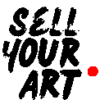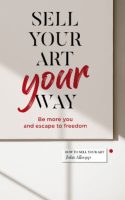Thank-you for all the comments on the last video, it’s all triffically exciting and I’ll try to address the “what-about” questions in this video.
So, in the last video we talked about how to research galleries and open up to wider possibilities. We saw that it’s a bit of a faff to do manually but you can if you like. But I mentioned I’ve semi-automated that job, so we’ll come to that but for now let’s look at how to gain the attention of a gallery.
Actually, gaining their attention is one thing, but being desirable to them is another, so that’s a hint at what video 3 will be all about.
I interviewed a wide variety of galleries, but they all said the same thing. What excites them is discovering an artist. I don’t know if it’s the thrill of the chase or what, but receiving a hundred emails a day from artists showing their portfolio drags them down, it’s a bind, a real downer for them. But if they follow their nose, do their own research and find an artist that they think they can sell to their collectors, that’s what energises them.
It also puts you in a great bargaining position. You’re not begging, they are coming to you.
So the strategy is to appear in their peripheral vision, to be around, to build up your chance of them finding you and considering you, without directly contacting them. That’s the other leap to take.
That’s a rule .. no direct contact with the gallery unless they contact you first.
Let’s look at practically how we might do this.
Personally, I would start with LinkedIn. There, I can probably find most of the people who are connected with a target gallery. I would collect those names, perhaps in a spreadsheet. Before starting to connect, I would check my LinkedIn profile and build it up, add some video and images, and tighten up my title and description and maybe profile pic. Then I’d follow the key people who are 2nd connections to you, no more than 10 such requests a day, and definitely not send any salesy/chatty/whatever message to them if they connect, unless they talk first.
Then I’d move to Twitter and Instagram and I’d go looking for the gallery and the accounts of those target people. On Twitter, you can create lists, so I’d create a private list, maybe call it ‘galleries’ and add them to that. On Instagram you would just follow them.
So then your daily routine is to look out for these people and their activities and to .. subtly, definitely not every day or anything, and where it’s right to .. like things they do and where you have something good to contribute without being salesy .. support what they are doing.
It’s really important to be completely supportive and non-threatening. So a message like this would be a no-no “that exhibition looks great, I do work like that here’s a link to my portfolio”.
If you do see that a gallery has exhibited an artist with work similar to yours then it’s compliments all the way “I love the way that .. “. It’s got to feel genuine to you and seem genuine to them. That’s different in different cultures so you’ll have to judge for yourself, but my take is there has to be no hint that you are in it for yourself.
The other mistake to avoid is .. we get all excited about these things and then our energy tails off, and that can look at the other end like “wtf is this person suddenly all over my notifications?” What we actually want is to start really slow and subtle, watch for interactions and desire, and build up where that happens .. exactly as you would in a real human relationship.
If you are chomping at the bit, you could put that energy into step 1 research. For instance with that similar artist exhibition, you could work out which galleries their supporters like, and maybe that way you’ll find a new prospective gallery.
The other possibility is to place pay per click ads (in Facebook and Instagram primarily). It’s possible, in theory, to create a list of individuals and target them directly with ads, but in practice you need to know their emails and the size of that list needs to be big enough so that’s a big-company tactic.
But you could target gallery owners and curators in general with social media ads and see which ones come to you. What sort of ad? Well, let’s look at that in the next video where we work on making you more compelling. And you’d need a Facebook Page and Instagram account that you maintain reasonably well, I imagine you already have that.
I am concerned that we’ve fallen into frantically scrabbling for likes by feeding the Facebook/Instagram monster with our energy. I’m backing away from that nowadays .. we want to be discovered, we don’t want to be jumping up and down and yelling for attention.
Of course, if you are geographically close to the gallery then absolutely turn up to their exhibitions and maybe post about how fantastic it was and so on. Write in the comments book. Maybe even wear something slightly different so they remember you. And before you go, just check the profile pics of the target people so you’d know them if you saw them .. not to jump on them, but just to acknowledge maybe if you’ve been batting things between you on social media.
I have a morning routine for LinkedIn, with a social media time-limiter app that stops me after half an hour and blocks Facebook and Twitter during that time slot. I wake up and turn to LinkedIn and check the newsfeed to see how nice and supportive I can be. Not just “that’s awesome”, but actually contributing thoughts, making links and so on.
So that’s getting discovered. In the next video, I’ll talk about the battle for desire .. you could do all this and get just two seconds of someone’s attention. We need to be compelling. That’s next.

